12 Simple Ways to Save Money on Groceries
This post may contain affiliate links. Read our disclosure policy here.
Need to trim your grocery budget even more? Here are 12 simple ways to save on groceries that you can use to save money without breaking a sweat.
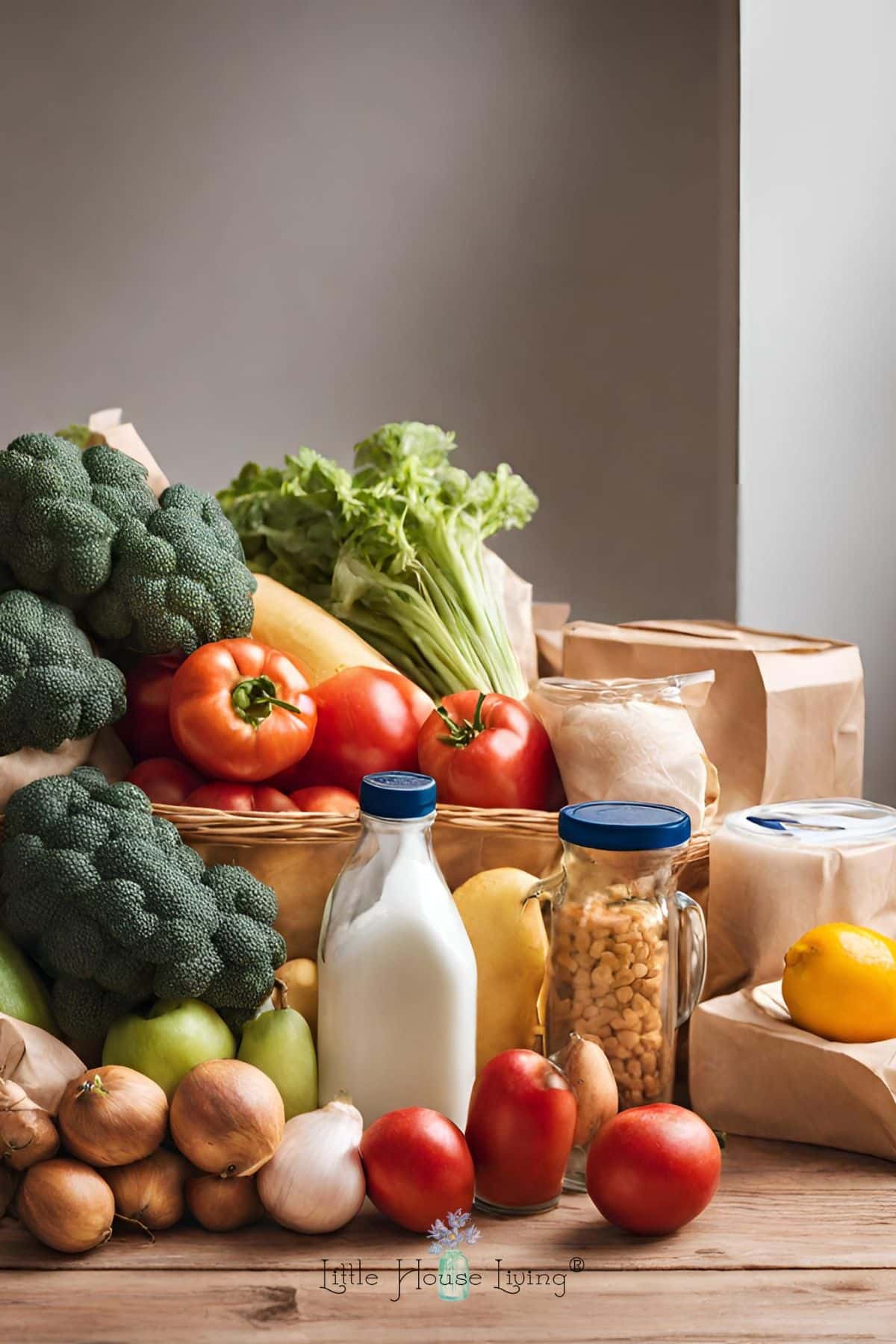
Ways to Save Money on Groceries
Whenever I look at ways to trim our budget, my thoughts turn to groceries first. It always seems like no matter how many times you set a food budget, after a few months it tends to disintegrate. It’s just way to easy to go to the store and add a few extra things to your cart here and there.
This isn’t going to be a list of ways to save money at the grocery store that you can find anywhere else because I already know that my readers know those tips. Grating your own cheese, skipping the pre-packaged foods, buying dried beans, grocery shopping without children when possible, skipping the shopping when you are hungry, buying generic brands instead of brand name…yeah, you already know those!
Even when you think you are a total pro at saving money on groceries, you probably haven’t tried all of the tips that I’m about to share with you. And if you have…awesome! Please email me if you want to write the follow-up article to this post on even MORE ways to save on your grocery bill!
We’ve used these methods in our own household to keep our food budget down to $400 a month for 5 of us. (This does not include beef which we raise ourselves and have a separate fund for.) It’s been a challenge each month to keep our bills down at this level since the cost of groceries here can be high and we are all on various diets for allergies. But I wanted to share these tips with you so you can feel encouraged…it can be done!
Tip: Find even more tips on How to Deal With Food Allergies On a Budget.
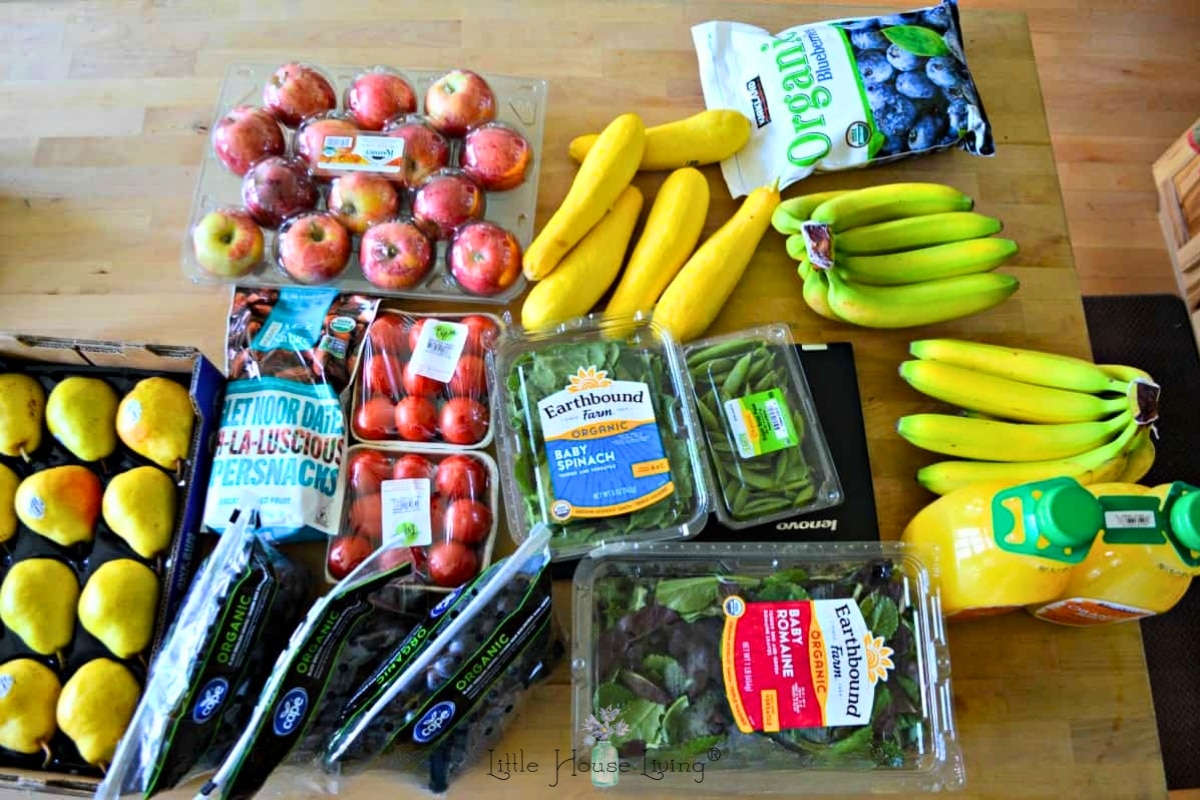
1. Shop Only in One Part of the Store
You really only need to shop in one section of the grocery store, the outside perimeter. There, you will find dairy, meat, and produce. You may occasionally stray to the middle aisles for baking supplies and spices, but that should be it. When you are on a tight budget, you don’t have room in it for “fancy extras” like pre-packaged snacks and whatever else they sell in those middle aisles (I honestly wouldn’t know; during the summer I rarely step a foot into a grocery store and in the winter it’s just to buy produce since we purchase meat in bulk!).
Desserts are a luxury and don’t need to be included in your diet when there isn’t money to spare. Bread can be made at home for pennies. Beverages (other than water) are almost never necessary. The trouble is that we get so used to eating certain things, or buying certain brands, or even making certain recipes, that we hesitate to move outside of our comfort zone and we don’t really even think in terms of what makes the most sense financially. To truly save money on groceries, we have to get outside of our safety net and expand our horizons.
2. Always, Always Have a Plan
And what goes along with this is always shopping with a list…no matter what.
Don’t be suckered into buying something on sale just because it’s on sale. On occasion, I will look at a grocery store flyer to see if what I need is on sale, but otherwise, I stick with my grocery list. Not because my list is made up of ideal recipes that I need to find the ingredients for, but because it’s filled with frugal staples that I know I can make stretch in many different ways.
Tip: Looking for ideas? 14 Cheap Meals to Make When You’re At The End Of Your Budget
3. Buy Your Meat in Bulk
I love that I don’t have to include meat in my regular grocery budget, it takes a huge stress off of our family each month and I know that I always have great meat in the freezer.
I’ve already mentioned that we raise our own beef. I currently get chicken from my mom or we grow our own.
Tip: I cover the topic of buying meat in bulk extensively here.

4. Use Savings Apps, Rewards Cards, and Extras
I’m new to the smartphone world so this is a new way for me to save money on groceries. While I don’t feel like HUGE savings can be achieved with apps, there is some money to be saved which makes it something to look at.
I’ve used the iBotta app to load cashback for both Hyvee and Walmart. We don’t usually buy many of the products advertised, but I have been able to find cashback in small amounts for any kind of produce or even a little cash back on any purchase at all. As I said, it doesn’t add up to much…$0.25 here and there, but it’s still something. They are now offering a $10 welcome bonus when you start using their app. Remember, iBotta is more of a rebate app so instead of a discount you eventually get an amount back. It’s better than not having anything at all though if you shop at the stores they have!
There are also loyalty programs or store discounts. These are extra coupons that you can load from your smartphone onto your phone number to be able to get a discount on certain items. I’ve found the most luck with this with Safeway and Target.
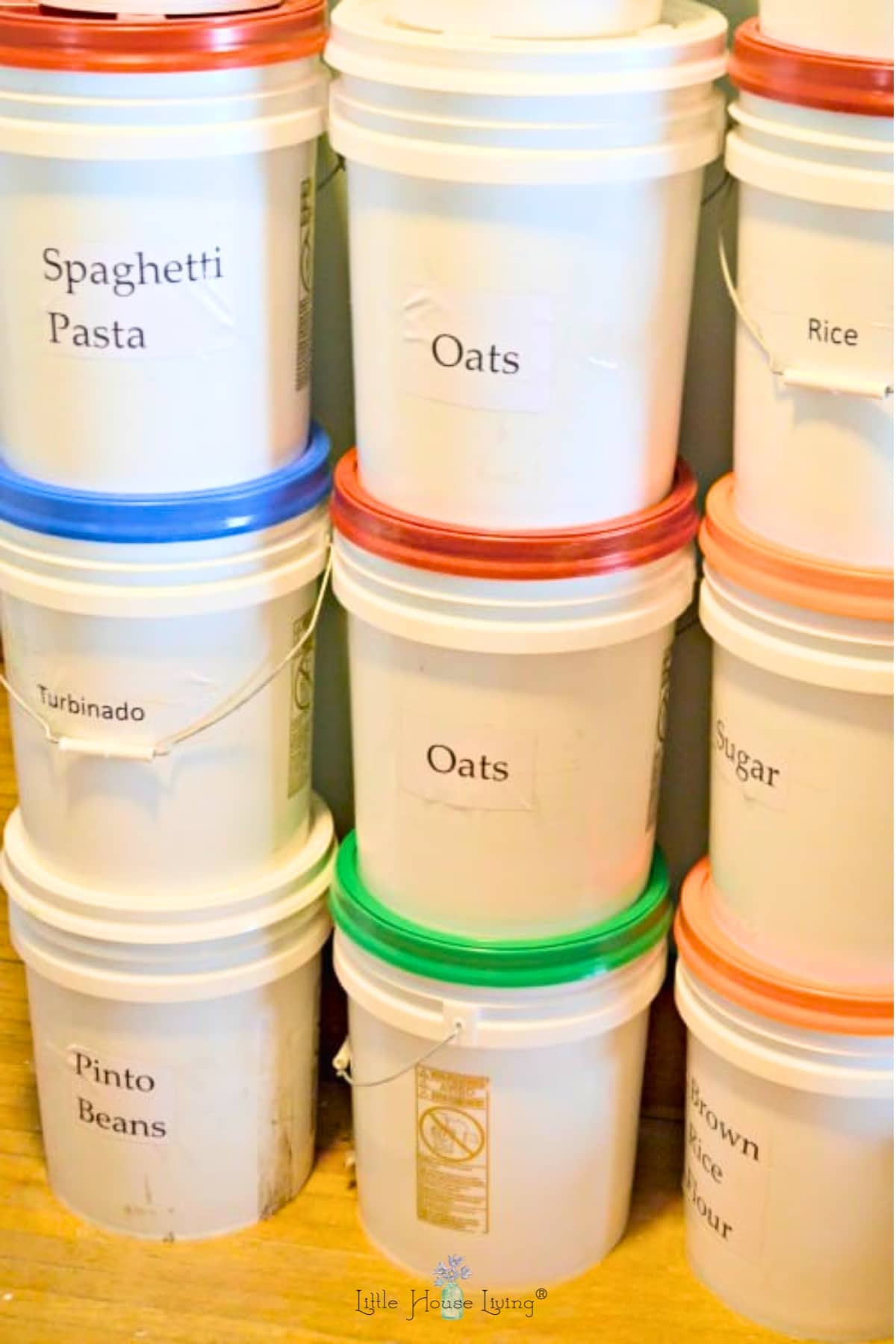
5. Utilize a Bulk Coop
I truly believe in the power of buying in bulk and have been doing it for many years now. Some items don’t make sense to buy in bulk, but many baking staples can be found at a fraction of the cost when you are willing to take more than a small package at a time. If you don’t have a bulk foods coop nearby, you could try Sam’s Club or Costco, but neither has the same deals as you would get in a typical coop and keep in mind that each has an annual fee or membership fee that you will have to pay to shop.
I won’t go into detail here on all the pros and cons of buying in bulk but I highly recommend that you check out my article on Buying from a Bulk Coop and the whole page of articles on Buying in Bulk here.
6. Use Subscribe and Save
I’ve been using Subscribe and Save on Amazon to save money on groceries and other household items for several years now. Not only can I save a significant amount off of what I would have to pay at the store, but I also don’t have to go anywhere to do it, it comes right to my door!
When you purchase any item on the Subscribe and Save program, you will save 5% off the price, and it will ship to your home on a certain day each month. You can leave the subscription so you get the item every month or cancel (or skip) it to only get what you need. If you get 5 or more items on your monthly subscription, your savings go up to 15% off. On top of that, coupons are offered each month for additional savings (usually 5-35%) on top of the regular discount. This is where the real deals come into play!
My favorite items to order with Subscribe and Save are toilet paper, some snack foods, tea-making supplies, vitamins, and things for the kids.
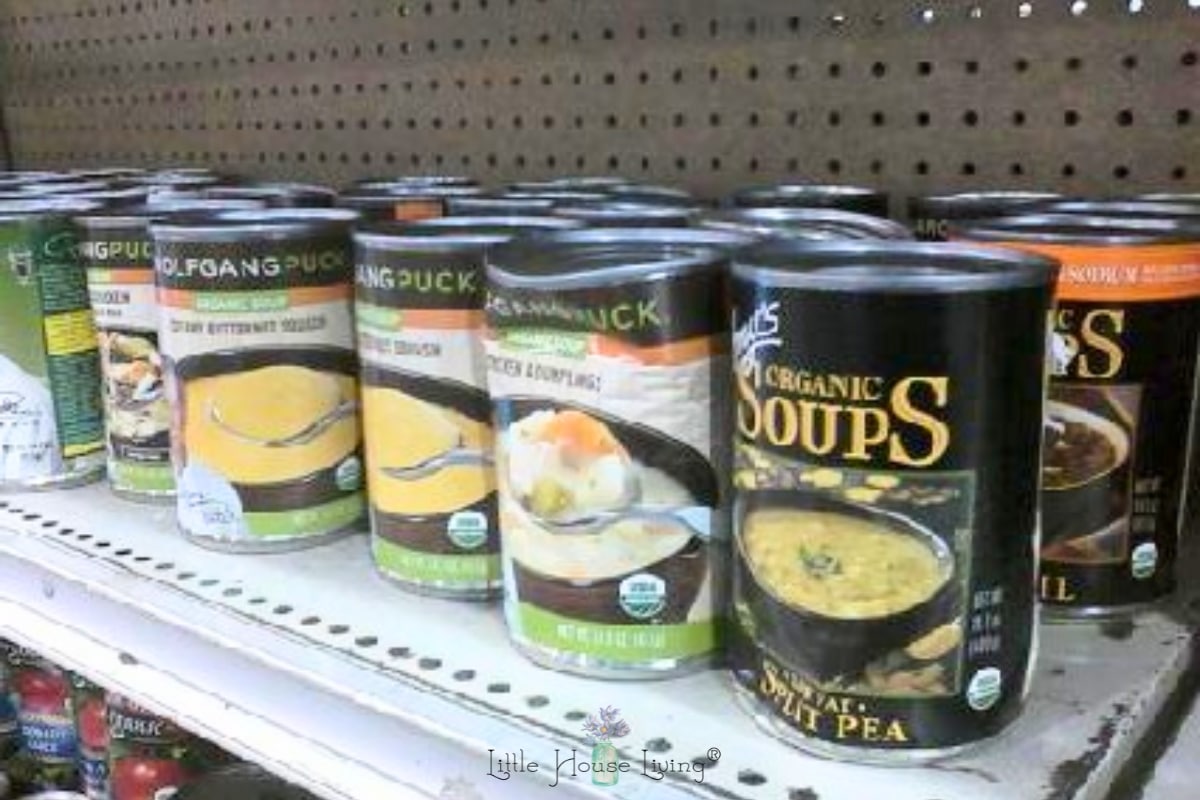
7. Find a Good Dent n’ Bent Store
Not all discount grocery stores or “dent n’ bent” stores have a good selection, but when you find one that does, it can be a major resource! Discount grocery stores offer products that are dented, close to an expiration date, or unable to be sold in a regular grocery store for some other reason. The products are usually offered at a huge discount off the regular price
Tip: Learn all about Discount Grocery Stores and how to shop them here.
If you do not have a Dent and Bent store nearby, check your local grocery stores for sections in them that have a shelf or a rack of discount products. Even our Safeway store has this in a hidden nook in the back. I don’t usually find much there but it’s worth checking!

8. Have a Price Book
How would you know whether or not to buy that bag of rice that is on sale for $1/lb if you don’t know what the regular price is? Or what you paid for it last month when another store had it on sale?
Having a price book can be one of the best things that you can do for your grocery budget. In it, you can keep track of all of the items that you regularly buy. You will also want to write down what your “buy” price would be and what your “stock up” price would be. Don’t write the regular price of the item…that’s not helpful; you need to know what you’ve purchased that item for before when it was actually a good deal and what would be such a good price on it that you need to stock up beyond what your family can use right now.
I used a little tiny notebook for my price book with different sections for fruits, veggies, baking products, etc. I can keep the price book in my purse so where ever I go, I will know what a good deal is, whether that’s at home shopping for groceries online or in the store.
If you aren’t sure how to get started, you can use this simple price book printable I made a few years ago.
9. Eat from the Pantry
How much food do you have in your freezer right now? In your pantry? I bet there is more available to you right in your own home than you would think.
Having a “pantry challenge” can be a great way to save money on groceries, but also a great way to eat up foods that you’ve already spent good money on and have probably forgotten about.
Tip: See what a real-life Eat from the Pantry Challenge looks like here and here and get inspired to do your own challenge here.

10. Consider a Drastic Eating Change
This tip isn’t for everyone, but it can save you a significant amount off your grocery bill each month. Have you ever considered seriously changing your diet to something that would be much more frugal? We tend to get caught up with our “comfort foods” so this can be a hard concept for everyone to grasp but it’s worth thinking about.
A year ago, I decided to go off dairy for health reasons. My oldest is already allergic to dairy and my youngest boy is lactose intolerant so when I went off dairy it was just my husband left eating dairy products. We stopped buying cheese, milk, etc, and noticed a HUGE savings on our monthly grocery bill. Now I’m able to put some of that money towards vegetables which are probably healthier for us anyway! It’s been a big lifestyle change, especially for me (I’m a cheese lover!) but it’s been worth it for us in more ways than one so it’s not a decision we regret.
Is there something in your food budget that you are eating now that may not be necessary…maybe even good for your health to cut it out?
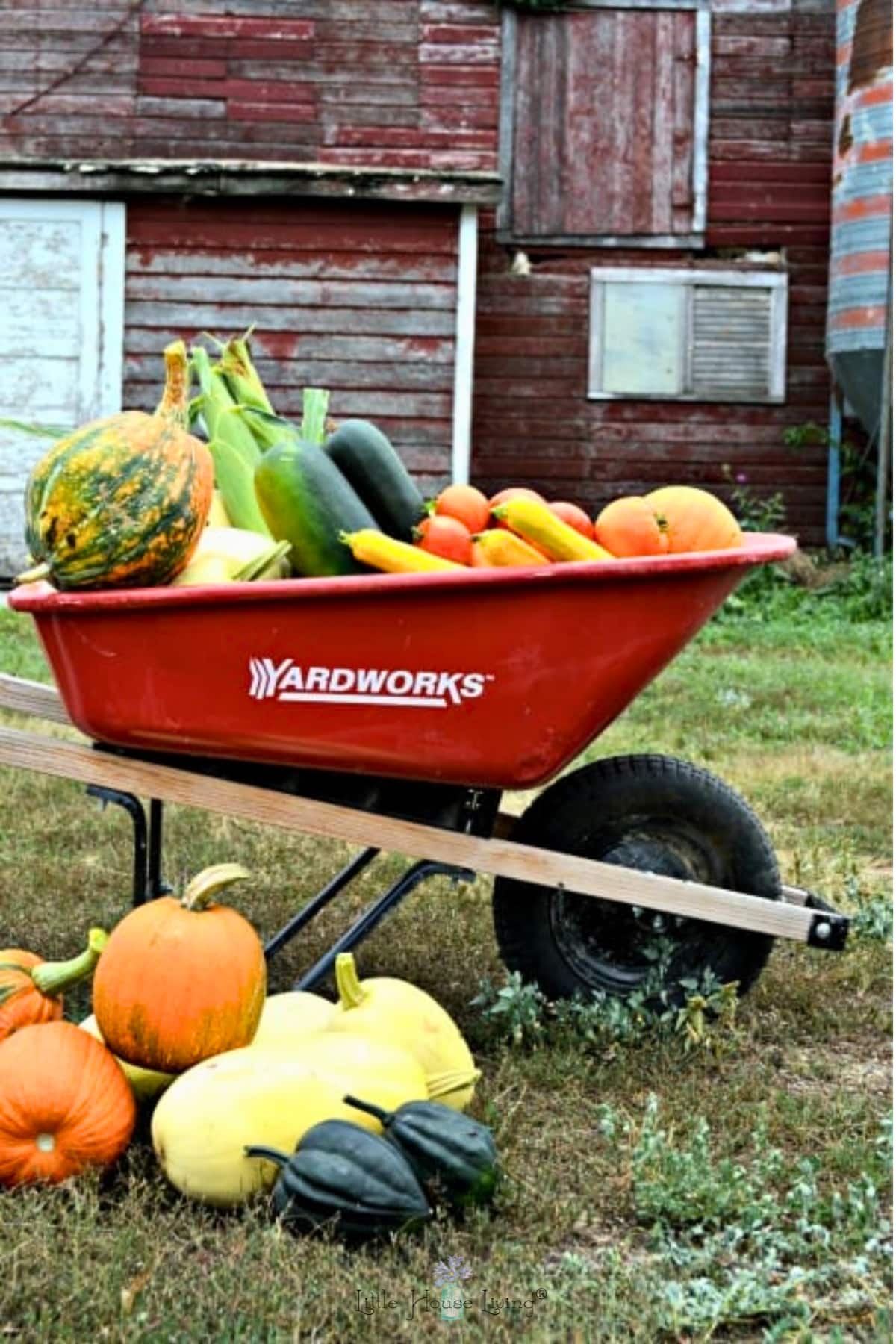
11. Grow It
Of course, this is one of my favorite tips! If you want to save money on groceries, you can grow your own. I believe that anyone can have some kind of garden no matter where you live. Even if you live in a city apartment, you can grow lettuce on your window sill. Just about any type of food that you can grow at home can save money on groceries. Yes, there are some costs involved with having a garden, but there are also some simple ways to save money on gardening.
And if you can’t start a garden right now in the season we are in, have you considered foraging? There are some great books out there, depending on the area you are in.
12. Make a Swap
If you are on a very limited budget and don’t even have enough to buy what you need to get by, this can be a great option. If you can find someone near to you that grows or raises their own food and has extras, consider asking them if they would swap with you. Perhaps you have a skill that they can use…plumbing, sewing, or maybe even pulling weeds! Ask if they would trade what you have for something they have.
Unless someone is obviously giving something away for free, don’t simply ask for a handout. They may have something extra they are willing to part with but they still put the time and effort into growing that or raising that food and they deserve to have a fair trade. If you aren’t sure who to ask, try one of the sellers at your local farmers market and see if they need any help in exchange for food.
Hear more about Saving Money on Groceries on this episode of
The Little House Living Show Podcast!

Any of these methods can help you save even more on your grocery bill each month. Even if you don’t feel like you have any other way to save money on groceries, there is always something that can be done.
Follow-up time! After writing this blog post several years ago, I have some questions that I always seem to get about saving money on groceries. I wanted to add the questions and answers to this blog post to round it out a little more. Hopefully, this is helpful to you!
How much per month should I spend on groceries?
I don’t think there is a *should* answer to this. Each family is going to be different based on what they can afford and where they live. You might live in an area where you can grow most of your own food, and then your grocery bill *should* be less than the average. You might also live in an area where groceries are expensive, and things might cost a little more per month. Figure out what you have to spend on groceries per month and then find the best places and ways to do that.
How can I buy groceries for a whole month?
Buy in bulk and meal plan! If you plan out your month of meals and know exactly what you need, you can then buy everything you need for the entire month at one time, saving you from extra shopping and impulse buys. Our family personally gets our groceries once every 3 weeks because that’s how often our bulk foods coop delivers.
What grocery store saves you the most money?
Any store that offers the best prices! For some, that might be the grocery store that offers the best loss leaders, or for others, that might be Walmart. It completely depends on where you live.
How can I drastically lower my grocery bill?
In addition to the basic rules about grocery shopping like shopping sales, buying store brand, avoid impulse purchases, use a shopping list, etc, follow the tips that I’ve shown above. The biggest ways to save on groceries will definitely be to barter, to grow your own, and to consider lifestyle changes. Here are more ideas on How to Get Free Groceries.
How can I live off $25 a week for groceries?
$25 per week for groceries would be $1.19 per meal per person or $4.76 per meal for a family of 4 ($100 per week). I think this would be hard but still doable, even with today’s groceries prices, if you had to do it. Check out this list of the Cheapest Food at the Grocery Store for ideas.
How can I cut my grocery bill and still eat healthy?
Our diet is mostly fruits, vegetables, meats, and some grains. We rarely buy packaged products unless they are on a super sale and I’m needing some travel snacks or something like that. Not buying pre-packaged foods saves us so much money and helps us to eat healthier! Does it take more time to cook from scratch? Yes. But we believe that the payoff is worth it.
How much does a normal person spend a month on food?
According to US Money News, for a thrifty budget for a family of four, you would spend $216.90 a week or $939.90 a month. That is for the “thifty plan” and the amounts just go up from there. If we were buying all of our groceries outright (we own a bulk foods coop so this is a little different for us), our family of 5 would be spending about $600 a month on groceries.
Share your best tips! What are some ways that you save money on groceries? Did you already know (and do) all of these tips and have even better ones for those who want to go further? Email me at [email protected]; I’d happily pay you to write an article on those tips to share with our community!

Merissa Alink
Merissa has been blogging about and living the simple and frugal life on Little House Living since 2009 and has internationally published 2 books on the topic. You can read about Merissa’s journey from penniless to freedom on the About Page. You can send her a message any time from the Contact Page.
This post on Ways to Save Money on Groceries was originally published on Little House Living in October 2017. It has been updated as of March 2024.



Great post, very informative. I do many of these tips already except for the Subscribe and save and the bulk co op. I’ll have to look into them for certain items. We have many allergies in my family, I’m sensitive to dairy, my son is too and also allergic to peanuts and tree nuts, so finding deals on certain foods can be difficult. I wish we had a bent and dent grocery store closer to us, the only one I know of is an hour away so we don’t get it it very often but we stock up when we do. Thanks for the ideas! Love your Blog!!
It is good that you can grow your own beef, but do you worry about the poor quality of the factory farmed chickens that Zaycon offers? I do eat Zaycon chicken, but I do it aware that it is not part of the 80% of my diet I try to do healthy (80/20 rule). Because pastured organic chicken costs more than grassfed organic beef!!
I know this article is about saving money on groceries — most always that ends up not being the healthiest way to eat. And many of us need to invest in our health.
I have a HUGE vegetable garden and fruit trees and a permaculture perennial garden that has a ton of culinary and medicinal herbs in it, but I still end up spending well over $400/mo in groceries for just my husband and I. I do buy boxed foods sometimes, but I care more about the meats and dairy that we put in our bodies (I will not go without dairy, however I do purchase raw grassfed A2 milk). And occasionally I will drink a Zevia Cola which is not cheap, but also not bad for you. It is a treat since I cut out all soda pop.
I also purchase local Spring water because that is the best for me, and I don’t drink tap water.
So things add up in the budget. Sometimes our bill is $600 for two of us, and we don’t include the times we go out to eat in that budget.
In short, no, I don’t worry about it. If I was rich enough to be able to afford all organic foods without it causing any hardship, then I might think of things differently. But I think having as little stress in our lives as possible is just as important as eating healthy, if not more so. You could eat one of the healthiest diets in the world and still be unhealthy if there is a large amount of stress in your life. We do the best we can on the income we have right now and Zaycon may not be organic but it’s hormone/antibiotic free. My high-allergy family has never had a reaction to the chicken we’ve gotten (and we’ve been buying it for about 6 years) so that’s a great thing as well. Everyone has to make the choice that is right for them within their means and for that reason, I don’t worry about and give myself that added stress of thinking our diet is not something it should be.
That was probably a longer answer than you expected but hopefully, it makes sense.
I started my “savings adventure” as I call it, by taking an average week and writing down EVERY single thing I consumed. And I do mean EVERYTHING. Every ounce of this or cup of that. Right down to water, coffee/tea etc. Then used that to look at what I am eating, and how much. I had originally started that because I was trying to figure out how much I needed to be decently prepared for an emergency for a few months. I already garden extensively and needed a better game plan there. What to plant more of, what to plant less.
Can a snack cake be replaced by a healthier apple or banana? Could I have a few meals that had beans and/or rice instead of meat? I was amazed at how much JUNK I was eating! And, that’s usually the most expensive thing on your grocery list. I managed to shed a few extra pounds, and not only am I healthier, but my checking account is as well.
Great tip, thanks for sharing!
These are such great tips beyond couponing and meal-planning. Thanks!!
Two more ideas… Find a local flour mill! We have an organic mill not to far from us in Ohio. Sells bulk organic grains…. Even sprouted flours! Way cheaper then the stores! This is a huge cost saver for me. It is called stutzmans farms and is located in millersburg ohio…. For those of you in Ohio. Omigosh…. They have so much, and I save so much money buying from them directly. Think they might do shipping. They are Amish and don’t have a website. They are certified organic thru o.e.f.f.a. So, you could look onlune under o.e.f.f.a. Directory.
Second money saver, keep husband out of the grocery store especially when he’s hungry. Lol! Seriously, do we really need multiple packs of Oreos? Lol!
Haha! Another great tip!
R. great idea. got to find a mill like. stutzman’s farm.i am going to look later today.
These are great tips, thanks! Years ago I kept a price book, and just the act of constantly checking shelf prices and writing them down got me to the point I no longer needed a physical price book. I have memorized the best prices for all of our regular purchases. But starting out with a price book, that was valuable to learn where I was wasting money or getting a good deal.
One thing I do is check over the receipt when I get home. If I see a high price, it catches my eye. (We’ve stopped eating macadamia nuts because they were one of those HIGH prices on the receipt.) Occasionally I’ll find a mistake, like the time I bought one, small onion for a recipe, and the store charged me for one BAG of onions.
Again, great post!
Great tip!
I might add one other possibility – I am in a suburb of a large city and nearby grocery stores and Walmart offer grocery pickup for free or a very small fee like $5. I started using this service due to some mobility issues and, much to my surprise, how much easier it has been to stay on budget when I stay OUT of the stores themselves! No temptation for impulse purchases has equaled savings, which came as a pleasant unplanned surprise as well as a revelation of just how good the stores are at getting shoppers to overspend. Just a thought for those who aspire to homesteading but have suburban lifestyles. Love your blog Merissa!
Yes, great idea!
You can also order groceries (or anything else) from Walmart.com. Shipping is free with a $35 order (verify this, I can’t remember at the moment.) I use this to buy my pantry staples and find that they carry things on their website that they don’t have in the store (including some organic and items for those with special diets.) I love that I save on gas and time and don’t have to take my children there. I don’t want my children to think life is about shopping so I’d rather reduce how many trips to the store we all have to do. Great advice, as always. Thank you!
I, too, have started using grocery ordering. I did it because I only shop approximately once a month & it’s a huge, stressful job. I did wonder, at first, why it was cheaper, even though the items were a bit more expensive than if I did ther shopping myself. I quickly figured out that I want impulse buying since I wasn’t actually in the building. Grocery ordering has been a wonderful blessing!
In some areas a “Bent and Dent” store is also called a Salvage store. Most of the ones in my state, Florida are all labeled that way. I do try to shop frequently, but I will say some of them try to get more money for their stuff there than the bogo sales at the local grocery store.
Another way to save in my area is Meal Deals. While some of these may contain processed food, there is a local Fresh Market that has started doing real meals. They call these “The Little Big Meal” and they are priced between $15 and $25. They usually have recipes with them and I can sometimes split the ingredients up to use with other meals I had in mine. For example, this week is Chicken Parm so it includes pre-breaded chicken breasts, noodles, tomato sauce, cheese and a salad kit. This kit is also a better idea than eating out as the cost is much cheaper! Oh, and my store does NOT have a limit on how many of these meals you can buy! So if you are entertaining, this can be another great idea when you don’t have time to plan out everything. Next week is their great burgers too!!
And Melissa, another way to save on groceries….Have standby meals. My mother always said to have like 5 different 30 minute meals with all ingredients on hand. So if you come home late, have a sick day or a hard day, whip up that meal. It helps with meal planning and you are always able to have dinner at home! Think pasta dishes, homemade pizza (or frozen), chili, etc.
Hope this helps!!!
More great tips, thank you!
I also buy from Zaycon, chicken breast, ground beef, sausage and bacon. Love all of it.
I always do have a list, but I also always shop the sale flyer. If I was planning to use broccoli but something else in on sale I almost always substitute that.
Amazing post. Will be looking to utilize as many of these as possible. For those without a “dent and bent” nearby, check out dollar stores. We recently got a LARGE Dollar Tree store right by our Aldi’s. They have awesome finds for only $1!
I wrote a similar post and you covered many of my tips but I have learned a few more ideas from you! I didn’t know they had specific stores for bent & dented food! Thanks so much!!
The Subscribe & Save on Amazon sounds interesting. I need to shop my pantry for sure! Thank you for sharing on Merry Monday! Hope to see ya next week!
Kim
Thanks for the tips. I’ve been toying with the idea of Zaycom Fresh for a while. I’ll think about it more seriously with your endorsement.
We love Zaycon! I hope you check them out 🙂 Let me know if I can help answer any questions on them.
Thanks for all these great tips — I use many of them, but I learned some new ones! Just wanted to say a special thanks for #12 and the cautionary note about asking for things. I had a friend who always asked for freebies when she saw something she wanted. When she seriously suggested I clean my bookshelves because she needed something to read and promised to sell them to a half price store when she was done so they would go to someone else who liked to read — –that was amazing. She was also the one who made it a point to always bargain at garage sales to get at least 50% off everything — even the three for a quarter picture frames from a little girl who was raising money for camp. And no, friend was not even close to poor. One can be too frugal when it infringes on others 🙂
Your friend isn’t too frugal…she is CHEAP. I would have told her to go to the library. Which she is already paying for with her property taxes.
It’s now 2020 and Zaycon is out of business…here are some other random thoughts–
* One of the biggest dent-n-bent stores is actually a chain. It is called the Grocery Outlet. I used to go there first, get what I could, and then head for the supermarket to fill the rest of my list. I am sure there are people here who have a Grocery Outlet nearby, don’t know what it is and never even been in the door. The stock changes often, so if you find something you like, buy a lot of it, because you may never see it again.
* My biggest savings come from having a list and sticking to it, shopping for killer deals (I read the ads every week) and doing the bulk of my shopping at Winco, where every item is .50 to $1.50 cheaper than anywhere else. They also sell bulk foods. I don’t use too many of them, but I always buy my spices that way. I just got enough basil to fill a spice jar for .44! It’s pennies on the dollar!
* I stockpile groceries rather than buy week-to-week. If something is cheap, I buy a lot of it.
* I am very cautious about buying food at Dollar Tree, because a lot of it comes from China. Always read the label! One of their very good deals is Hanover canned baked beans. They are similar to Bush’s original, but always $1 can.
* I also keep steak around! It’s for days when I am pressed for time or really don’t want to cook. I can produce a steak and baked potato dinner faster than I can go to McDonalds, and for a whole lot le$$. Nobody ever complains about a steak dinner, either!
Thank you for the tips. My own advice to save on groceries while shopping : only pay with cash and bring with you only a small amount (in France, I take 150 euros to go shopping). So, I’m obliged to buy only what is necessary and not more.
As vegetarians, we don’t buy meat at all, which saves a lot of money by itself. Bonus: We don’t have to worry about the quality of the meat or how poorly the animals were treated. Just a thought. Thanks for the tips!
Merissa,
One of the strangest places for me to find a great bargain with food was at an auction. I saw signs and wasn’t going to stop but that little voice was screaming so I did. They were selling 50 pound bags of pinto beans – there must have been 20 – 30 of them – for $25 dollars. There were a couple of bags that were opened that no one wanted and I got them for $5 each. There was about 35 pound of lentils in one and 40 pounds of kidney beans in the other. No one wanted these because they were opened but I got a great deal and the dried beans went into our long term food storage. I still have some cans of these and they are just fine.
Maureen
Great deal!
Great tips! I do about half of these already, but I haven’t tried the apps and online stuff yet. I always felt those were overwhelming on my own, so I’m happy to have the recommendations!
I’ve never tried a pantry challenge but it sounds interesting. I may try that very soon. Great tips!
These are really awesome tips. I do #1 and #2 a lot but the rest of these are so good, too! I had never heard of Subscribe & Save. I am definitely going to check that out! Great post.
There is also receipt pal, receipt hog, dosh and fetch. I love them all! I even have one page on my phone that is nothing but ‘savings app’ so i dont forget. Alot give u ‘points’ that u can redeem for giftcards so its a different way to earn back on stuff u already do.
These are all such great tips. Especially the one about trading some work for produce and the one about eating more frugal meals. I know that oftentimes I could choose more frugal meals than I do. We grow a fairly large garden and usually have more than we can eat/can/dehydrate so I would love to be able to give it away to someone that needed it. Thanks for the great tips.
Great suggestions! Thanks, Merissa! I do some of these, but not all.
These tips are probably better for people who live in cities, but I can’t be your only reader who does, so I’ll give them anyway:
First, check to see if any retailers have an outlet store near you–we have a bakery here that has an outlet for their bread that’s going bad too quickly and you can get it for 50-75% off retail. It’s the good stuff too. If there’s a specialty bread you want and it’s not something you can easily make at home (for me, that’s English muffins), it can be a great resource.
Another is to shop at ethnic markets, which often have produce for pennies on the dollar compared to American grocery stores. Bonus: you can try new things you’ve never had before. We have a Chinese grocery store here with an enormous selection of produce where you can get huge napa cabbages for 30 cents a pound. There are also a ton of different leafy greens, which are super healthy, and they have plenty of Western vegetables as well. And of course, you can get 50 lb bags of rice there too. If you like cuts of meat that don’t often show up at the grocery store (e.g. tripe, pork bones for broth), and you don’t have the means to go to a butcher or farm directly for those items, this is a good place to get them.
This one’s obvious but I’m already here, so I’ll share it: freeze everything. Stilltasty.com has tips on what foods freeze best and the use-by dates so you can avoid waste, but if it’s inevitable, try freezing the item so it doesn’t go bad. A handful of foods not everyone thinks to freeze: tomato paste, ginger, lemon juice/zest (or juiced/zested lemon rinds for infusing water or tea), yogurt, salsa (yup, even the fresh/pico de gallo type), cooked rice. Rice freezes very well and is easily reheated in the microwave. Also, I learned in college that rice can be eaten with just about anything to stretch it–if I don’t have tortillas, I just eat taco meat on white rice!
I know everyone already knows to make their own broth from chicken bones, but another thing you can do, if you grow your own produce or trust where it came from, is freeze every single scrap (including things like onion peels, corn cobs, the stems of mushrooms) and make your own vegetable broth once you have a big enough bag of scraps.
And then my last tip is to have some cooking things on hand to make frugal food taste a little more interesting. You can buy a huge bottle of hot sauce, for example, and add a little bit of it to things so the same frugal foods don’t get too boring. Hope these were helpful!
Thank you for sharing your tips. I already do most of these to save money and for some reason I can remember the price of everything in my cart when at the register; which helps because the stores tend to “misprice” items by a few pennies and that can add up. I mostly catch it due to the stores gaining a huge amount of money at the end of the day from all shoppers not paying attention. I will also make extra when making certain meals and freeze for that last minute meal in the future. When I make meatloaf, I make three and freeze two, burritos are the same. I will cook hamburger and chicken with seasoning and freeze for hotdishes or soups later. You get where I’m going with this. I will also freeze leftovers for another dinner later if there’s enough. You have good advice, thank you
Thank you for your ideas. I have been doin subscribe and save for years. Costco also does delivery on those bulky things and most of their non-perishables but I do think that there is a minimum to get free shipping. We are challenged by no dairy, gluten, onions or garlic.